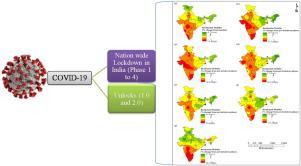当前位置:
X-MOL 学术
›
Int. J. Infec. Des.
›
论文详情
Our official English website, www.x-mol.net, welcomes your feedback! (Note: you will need to create a separate account there.)
Lockdown and unlock for COVID-19 and its impact on residential mobility in India: an analysis of the COVID-19 Community Mobility Reports, 2020
International Journal of Infectious Diseases ( IF 8.4 ) Pub Date : 2021-03-01 , DOI: 10.1016/j.ijid.2020.11.187 Jay Saha , Pradip Chouhan
International Journal of Infectious Diseases ( IF 8.4 ) Pub Date : 2021-03-01 , DOI: 10.1016/j.ijid.2020.11.187 Jay Saha , Pradip Chouhan

|
BACKGROUND
As an upshot, the countrywide lockdown and unlock period due to the COVID-19 pandemic has been supportive of altering residential mobility trends in India. OBJECTIVE
The study also investigated the impact of COVID-19 lockdown and unlocks period on residential mobility trends, using spatial-time series daily change across different states and union territories of India. DATA & METHODS
This study has been based on time-series data of the daily percentage of change of residential mobility from baseline in India. Conditional formatting techniques, box plotting, time-series trends plotting method, spatial kriging interpolation mapping techniques have been employed to show mobility trends. RESULTS
About 31.5%, 30.8%, 26.2%, 23%, 17.6%, and 18.2% of the increase in residential mobility from the pre-lockdown phase are observed during lockdown phase 1, phase 2, phase 3, and phase 4 unlock 1.0, and unlock 2.0 in India respectively due to people move towards home or place of residence during the COVID-19 pandemic in India. After lockdown initiated, up to 31 st July 2020, residential mobility has been less increased in the north-eastern states of India and also eastern and extreme northern states of India. CONCLUSION
Study can be used in public health strategies to drop the spread of COVID-19.
中文翻译:

COVID-19 的锁定和解锁及其对印度住宅移动性的影响:对 2020 年 COVID-19 社区移动性报告的分析
背景作为一个结果,由于 COVID-19 大流行而导致的全国封锁和解锁期一直支持改变印度的住宅移动趋势。目标 该研究还使用印度不同州和联邦属地的空间-时间序列每日变化,调查了 COVID-19 锁定和解锁期对住宅流动趋势的影响。数据与方法 本研究基于印度住宅流动性每日变化百分比的时间序列数据。条件格式化技术、箱线图、时间序列趋势绘图方法、空间克里金插值映射技术已被用于显示移动趋势。结果约为 31.5%、30.8%、26.2%、23%、17.6% 和 18。在锁定阶段 1、阶段 2、阶段 3 和阶段 4 分别在印度解锁 1.0 和解锁 2.0 期间观察到与锁定前阶段相比住宅流动性增加的 2%,原因是在锁定期间人们向家或居住地移动印度的 COVID-19 大流行。封锁开始后,截至 2020 年 7 月 31 日,印度东北部各邦以及印度东部和最北部各邦的居民流动性增加较少。结论 研究可用于公共卫生策略以减少 COVID-19 的传播。印度东北部各邦以及印度东部和极端北部各邦的居民流动性增加较少。结论 研究可用于公共卫生策略以减少 COVID-19 的传播。印度东北部各邦以及印度东部和极端北部各邦的居民流动性增加较少。结论 研究可用于公共卫生策略以减少 COVID-19 的传播。
更新日期:2021-03-01
中文翻译:

COVID-19 的锁定和解锁及其对印度住宅移动性的影响:对 2020 年 COVID-19 社区移动性报告的分析
背景作为一个结果,由于 COVID-19 大流行而导致的全国封锁和解锁期一直支持改变印度的住宅移动趋势。目标 该研究还使用印度不同州和联邦属地的空间-时间序列每日变化,调查了 COVID-19 锁定和解锁期对住宅流动趋势的影响。数据与方法 本研究基于印度住宅流动性每日变化百分比的时间序列数据。条件格式化技术、箱线图、时间序列趋势绘图方法、空间克里金插值映射技术已被用于显示移动趋势。结果约为 31.5%、30.8%、26.2%、23%、17.6% 和 18。在锁定阶段 1、阶段 2、阶段 3 和阶段 4 分别在印度解锁 1.0 和解锁 2.0 期间观察到与锁定前阶段相比住宅流动性增加的 2%,原因是在锁定期间人们向家或居住地移动印度的 COVID-19 大流行。封锁开始后,截至 2020 年 7 月 31 日,印度东北部各邦以及印度东部和最北部各邦的居民流动性增加较少。结论 研究可用于公共卫生策略以减少 COVID-19 的传播。印度东北部各邦以及印度东部和极端北部各邦的居民流动性增加较少。结论 研究可用于公共卫生策略以减少 COVID-19 的传播。印度东北部各邦以及印度东部和极端北部各邦的居民流动性增加较少。结论 研究可用于公共卫生策略以减少 COVID-19 的传播。


























 京公网安备 11010802027423号
京公网安备 11010802027423号